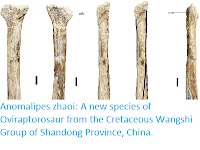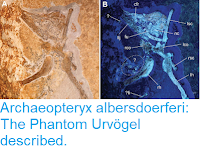Small Dinosaur tracks assigned to Minisauripus have been described from a number of locations in China and Korea since the ichnogenus was first described in 1995 (trackways and other animal traces are often placed in to ichnospecies and ichnogenera by scientists that study them, a form of taxonomy that follows the same form as the classification of living species, and which, if unable to record actual biological relationships, at least serves to group traces according to shared similarities). The first instances of these tracks were originally ascribed to a small Ornithopod Dinosaur, and were thought to be of Late Cretaceous age, but further examination of both the tracks and the local geology suggests that they were made by a small Theropod, and are of Early Cretaceous age, with all subsequently discovered examples being of similar age.
In a paper published in the journal Scientific Reports on 14 February 2019, Kyung Soo Kim of the Department of Science Education at Chinju National University of Education, Martin Lockley of the Dinosaur Trackers Research Group at the University of Colorado Denver, Jong Deock Lim of the Korean Cultural Heritage Administration, and Lida Xing of the School of the Earth Sciences and Resources at the China University of Geosciences, describe a new instance of Minisauripus from the Jinju Formation of South Korea, exposed during excavations at the Ppuri Industrial Complex in Jinju Innovation City.
The Jinju Formation has already yielded a number of significant trackways from other, nearby, locations, which are housed in the nearby Jinju Pterosaur Footprint Museum. The new material comprises a thin slab of fine grey sandstone covered by a thin black mudstone drape, less than a millimetre thick, on which a pair of Minisauripus tracks are preserved as impressions, a larger counterpart slab in which these, plus two other similar tracks, making a four imprint trackway are preserved in negative epirelief, and a third slab with a single footprint impression, which was probably part of the same trackway. The counterpart slab also preserves two Pterosaur manus (hand) impressions, a number of invertebrate traces ascribed to large Nematode Worms, and some raindrop marks.
The trackways are all very well preserved, with the exception of one of the negative relief tracks, which is partially obscured by an overlying Pterosaur track. The prints average 2.38 cm in length and 1.93 cm in width. The average step length (one footprint to the next) is 20.03 cm, while the average stride length (one footprint to the next made by the same foot) is 39.60 cm. All of the footprints preserve skin traces from the entire foot, something unknown on any other Dinosaur footprint of any size. This applies to both the impressions and the negative epirelief prints, which effectively form a mould of the foot of the living animal. The traces show evidence of skin between digits II and III, and II and IV, which may indicate evidence of skin between the digits, or of loose skin on the side of the digits that was pushed down between the toes when the foot was fully flat.
The Pterosaur tracks are larger than those of the Dinosaur, measuring 14 cm long and 7 cm wide, and 13 cm long and 8 cm wide. Both are manus (hand) prints, with no sign of marks made by the pes (foot); the prints are not orientated in the same direction, and are probably not part of a single trackway.
The size of the Minisauripus footprints (2.38 cm in length) is taken to indicate an animal with a hip height of about 10.71 mm, which again, assuming a fairly standard Theropod body shape would indicate an animal about 28.4 cm long, and weighing a few tens of grams (about the size of a Blackbird). The stride length is estimated to indicate a walking speed of between 2.27 and 2.57 m per second (8.19 and 9.27 km per hour). The presence of skin traces without any smudging suggests that the foot was placed firmly down on the ground and lifted without any sliding, either in one solid step or with a rolling movement in which the back of the foot hit the ground before the back, but no movement of the foot on the ground occurred.
The consistent small size of Minisauripus footprints across a wide area of China and Korea, with no similar larger footprints, strongly suggests they were made by a full-sized animal, rather than a juvenile member of a larger species. The small size might potentially represent a Bird rather than a non-Avian Theropod, but no Bird with a foot similar to Minisauripus is known from the Early Cretaceous.
See also...
(A) Counterpart slab CUE JJ_M01 showing trackway with four consecutive Minisauripus track casts TL1-TR2. (B) Natural impression slab (CUE JJ_M02) showing tracks TL2 and TR2. (C) Isolated track specimen (CUE JJ_M03). Kyung Soo Kim in Kim et al. (2019).
(A,B) Natural impression (A) and cast (B) of track TL2 showing area enlarged in frame (F). Note skin traces in hypex area between digits II and III. (C) Natural cast of track TR1, showing area enlarged in frame (E). Note narrow, digit II intersecting raindrop impressions. (D) Isolated track t. Note skin traces in hypex area between digits II and III. (E) and (F) details of skin trace ornament in 2.0 × 2.0 mm areas of digits IV and II respectively from tracks TL2 and TR1. Casts show in frames (B)-(F) are essentially replicas of the living foot. Kyung Soo Kim in Kim et al. (2019).
The Pterosaur tracks are larger than those of the Dinosaur, measuring 14 cm long and 7 cm wide, and 13 cm long and 8 cm wide. Both are manus (hand) prints, with no sign of marks made by the pes (foot); the prints are not orientated in the same direction, and are probably not part of a single trackway.
The size of the Minisauripus footprints (2.38 cm in length) is taken to indicate an animal with a hip height of about 10.71 mm, which again, assuming a fairly standard Theropod body shape would indicate an animal about 28.4 cm long, and weighing a few tens of grams (about the size of a Blackbird). The stride length is estimated to indicate a walking speed of between 2.27 and 2.57 m per second (8.19 and 9.27 km per hour). The presence of skin traces without any smudging suggests that the foot was placed firmly down on the ground and lifted without any sliding, either in one solid step or with a rolling movement in which the back of the foot hit the ground before the back, but no movement of the foot on the ground occurred.
The consistent small size of Minisauripus footprints across a wide area of China and Korea, with no similar larger footprints, strongly suggests they were made by a full-sized animal, rather than a juvenile member of a larger species. The small size might potentially represent a Bird rather than a non-Avian Theropod, but no Bird with a foot similar to Minisauripus is known from the Early Cretaceous.
See also...
Follow Sciency Thoughts on
Facebook.








